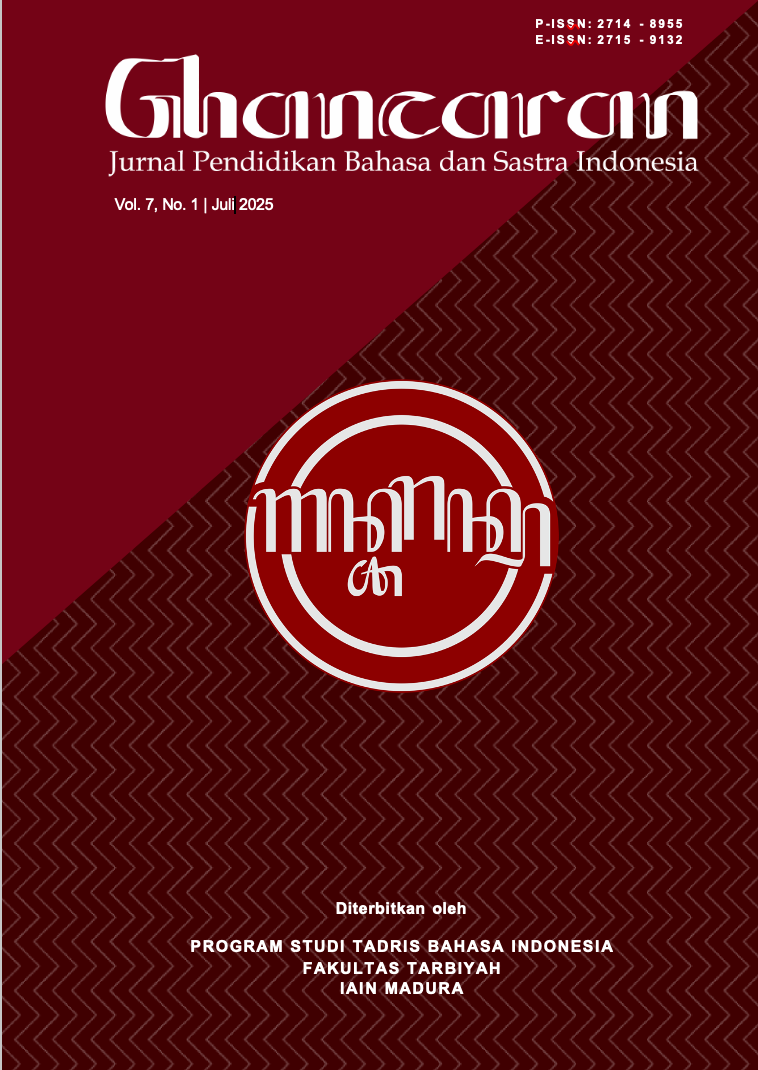Citra Salat yang Bergeser pada Poster Film Makmum: Ibadah Mistik, Skeptisisme Masyarakat, dan Semiotika Peircean
 Abstract views: 325
,
Abstract views: 325
,
 PDF downloads: 193
PDF downloads: 193
Abstract
Penelitian ini bertujuan untuk mengkaji representasi salat dalam poster film Makmum mengalami pergeseran makna menjadi ritual yang bernuansa mistik dan horor. Metode yang digunakan adalah deskriptif kualitatif dengan pendekatan semiotika Peirce. Data dikumpulkan melalui observasi visual terhadap elemen-elemen desain poster, kemudian dianalisis berdasarkan tiga kategori denotatum dalam kerangka sign semiotika Peircean; ikon, indeks, dan simbol. Hasil penelitian menunjukkan bahwa penggunaan elemen visual seperti ruang kosong, pencahayaan gelap, serta entitas misterius di belakang perempuan yang sedang salat membentuk interpretasi baru yang menyimpang dari makna spiritual salat itu sendiri. Konklusi dari penelitian ini menegaskan bahwa konstruksi tanda dalam poster Makmum telah membentuk makna alternatif yang sarat atmosfer horor, sehingga mengaburkan pemaknaan ibadah sebagai aktivitas yang damai dan menenangkan. Penelitian ini juga berkontribusi dalam mengkaji relasi antara visual populer dan representasi nilai-nilai keagamaan dalam konteks budaya visual kontemporer.
Downloads
References
Ahmed, S. (2019). The Islamist Exclusion of Women from Public Space. Telos, 188, 33–53.
Aiello, G. (2006). Theoretical Advances in Critical Visual Analysis: Perception, Ideology, Mythologies, and Social Semiotics. Journal of Visual Literacy, 26(2), 89–102.
Azis, A. (2024). Hubungan Salat Tahajud terhadap Kecerdasan Spiritual. Jurnal Ilmiah Al-Muttaqin, 9(2), 39–48.
Basir, M. A. (2022). Islamic Literature Criticism of Horror Films: Analysis of The Main Characters of Film Munafik 2 (2018) and Makmum (2019). Al-Qanatir: International Journal of Islamic Studies, 27(2), 116–125.
Bayma, T. (1995). Art World Culture and Institutional Choices: The Case of Experimental Film. The Sociological Quarterly, 36(1), 79–95.
Chun, C. H. (2020). A Study on the Elements of Moving Poster Design. Journal of Korea Multimedia Society, 23(2), 361–367.
Freadman, A. (1996). Peirce’s Second Classification of Signs. Peirce’s Doctrine of Signs: Theory, Applications, and Connections. Berlin: Mouton de Gruyter.
Ghassani, F., & Purisari, R. (2021). Analisis Pengaruh Fenomena Ruang Rumah Ibadah Terhadap Perilaku Sakral Pengguna Studi Kasus Masjid Istiqlal Jakarta. Prosiding Seminar Nasional Desain Sosial (SNDS), 3(1), 249–264.
Gorter, D. (2006). Introduction: The Study of the Linguistic Landscape as a New Approach to Multilingualism. International Journal of Multilingualism, 3(1), 1–6.
Gorter, D. (2018). Linguistic Landscapes and Trends in the Study of Schoolscapes. Linguistics and Education, 44, 80–85.
Greenwood, S. (2020). The Nature of Magic: An Anthropology of Consciousness. New York: Routledge.
Jawer, M. A., Massullo, B., Laythe, B., & Houran, J. (2020). Environmental "Gestalt Influences" Pertinent to Studies of Haunted Houses. Journal of the Society for Psychical Research, 84(2), 65–92.
Jazuli, M. (2022). Representasi Muslimah dalam Cuplikan Film Makmum 2. Skripsi Tidak Diterbitkan. Kudus: IAIN KUDUS.
Koslofsky, C. (2011). Evening’s Empire: a History of the Night in Early Modern Europe. Cambridge: Cambridge University Press.
Kralemann, B., & Lattmann, C. (2013). Models as Icons: Modeling Models in the Semiotic Framework of Peirce’s Theory of Signs. Synthese, 190, 3397–3420.
Kress, G., & Van Leeuwen, T. (2020). Reading Images: The Grammar of Visual Design. New York: Routledge.
Mujahidin, E., Rachmat, R., Tamam, A. M., & Alim, A. (2022). Konsep Manajemen Waktu dalam Perspektif Pendidikan Islam. Edukasi Islami: Jurnal Pendidikan Islam, 11(1), 129–146.
Muslih, M., Mun’im, M. A., & Mahbubah, K. (2021). Mukena in Madurese Social Life. Islamica: Jurnal Studi Keislaman, 15(2), 223–241.
Nash, J. (2016). Is Linguistic Landscape Necessary? Landscape Research, 41(3), 380-384.
Pamungkas, A. (2019). Sutradara Makmum Terharu Filmnya Bikin Orang Ketakutan. Okezone.Com.
Peirce, C. S. (1991). Peirce on Signs: Writings on Semiotic by Charles Sanders Peirce (James Hoop). The University of North Carolina Press.
Pryshchenko, S. V. (2021). Cultural heritage of a poster: communicative and creative experience. Creativity Studies, 14(1), 18–33.
Rosyadi, I. A. (2021). Masjid dalam Fungsi, Arti, dan Tonggak Sejarahnya. Diakses dari https://kemahasiswaan.uii.ac.id/masjid-dalam-fungsi-arti-dan-tonggak-sejarahnya/ pada 10 September 2024.
Safitri, T. S., & Atikurrahman, M. (2023). Anjing Menggonggong Muazin Berlalu: Toa Masjid, Gus Yaqut, dan Semiotika Morris. GHANCARAN: Jurnal Pendidikan Bahasa dan Sastra Indonesia, 4(2), 189–207.
Setyawan, S. (2023). Epistemologi Waktu Pagi dalam Al-Qur’an (Hikmah Pembagian Wakti Pagi: Sahur, Fajr, Subuh dan Dhuha). Kordinat: Jurnal Komunikasi Antar Perguruan Tinggi Agama Islam, 22(1), 112–123.
Soewardikoen, D. W. (2019). Metodologi Penelitian: Desain Komunikasi Visual. Yogyakarta: PT Kanisius.
Solichin, S. (2023). Analisis Hadis Wanita Lebih Utama Shalat di Rumah dengan Pendekatan Sosio Historis. Skripsi Tidak Diterbitkan. Pekalongan: UIN KH Abdurrahman Wahid Pekalongan.
Sontag, S. (1970). Posters: Advertisement, Art, Political Artifact, Commodity. In The Art of Revolution: 96 Posters from Cuba (Dugald Stermer). New York: McGraw- Hill.
Suedfeld, P., & Mocellin, J. S. P. (1987). The "Sensed Presence" in Unusual Environments Peter Suedfeld. Environment and Behavior, 19(1), 33–52.
Tresch, N. H. (2023). Image and the Law-a Peircean Approach to Mask Required Posters During the COVID-19 Pandemic. In Research Handbook on Legal Semiotics (pp. 366–375). Edward Elgar Publishing.
Udasmoro, W. (2018). Dari Doing ke Undoing Gender: Teori dan Praktik dalam Kajian Feminisme. Yogyakarta: UGM PRESS.
Warbain, N. (2020). Implementasi Nilai-Nilai Sosial Profetik dalam Realitas Dakwah Film Makmum. Skripsi Tidak Diterbitkan. Surabaya: UIN Sunan Ampel Surabaya.
Widodo, J. S. (2022). The Representation of the Islamic Religious Leader in Film “Makmum” by Riza Pahlevi. Journal Albion: Journal of English Literature, Language, and Culture, 4(1), 13-17.
Winfried, N. (1990). Handbook of Semiotics (Thomas A.). Indianapolis: Indiana University Press.
Zago, L., Fenske, M. J., Aminoff, E., & Bar, M. (2005). The Rise and Fall of Priming: How Visual Exposure Shapes Cortical Representations of Objects. Cerebral Cortex, 15(11), 1655–1665.
Zhou, L.-F., & Meng, M. (2020). Do You See the “Face”? Individual Differences in Face Pareidolia. Journal of Pacific Rim Psychology, 14, 1-8.
Copyright (c) 2025 GHANCARAN: Jurnal Pendidikan Bahasa dan Sastra Indonesia

This work is licensed under a Creative Commons Attribution-ShareAlike 4.0 International License.
Ghancaran: Jurnal Pendidikan Bahasa dan Sastra Indonesia uses an Open Access Policy under the Creative Commons Attribution-ShareAlike 4.0 International License. Authors publishing in this journal agree to the following terms:
- Ghancaran Journal holds the copyright and grants the journal rights for first publication with the work simultaneously licensed under a

The work is distributed under Creative Commons Attribution-ShareAlike 4.0 International License which allows others to share, copy, and redistribute the material in any media or format and adapt, remix, change, and develop the material even for commercial purposes, as long as it is stated credit and license derivative works under similar terms. - Authors may make additional contractual arrangements for non-exclusive distribution of the journal's published work version.
- Authors are permitted to post their work online (e.g., in institutional repositories or on their websites) before and during submission, as doing so may lead to productive exchange.


















